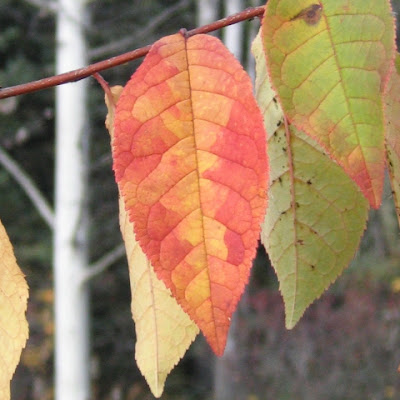Do you wonder about the best way to clean and care for your sterling or copper jewelry? There's no single best answer.
Probably the first thing to consider is whether you're dealing with tarnish or with a patina. The two conditions are similar and the difference is largely in the eye of the beholder: If you don't like the dark coloration, you probably call it tarnish. If you do like it — or if it is part of the artist's design for your piece — it's a patina.
For instance, take a look at these two bead rings.
Both are sterling silver wire with a carnelian bead. I just made the top ring; I've worn the bottom one on and off for several years. Personally, I think the patina improves the older ring by accentuating the curved lines of the wire, but to other eyes, it may simply look tarnished. It's case of personal preference.
Sometimes the artist has decided to add coloration as part of the design of the piece. For instance, the embossed leaves would not show up if the Forest Floor Cuff lacked a patina.
In contrast, the high shine works well for the Folded Cuff because it shows off the smooth fold against the dimples of the hammered surface.
In these Random Copper Dots earrings, the difference between patina and clean, polished metal is a key part of the design. The dark patina shows off the embossed pattern and contrasts nicely with the bright, shiny copper beads on the earwires.
So, to get back to the original question about cleaning and caring for copper and sterling silver: As in medicine, the best cure is prevention.
If you want to avoid tarnish, gently clean your jewelry with a soft cloth before putting it away. This removes oil and dirt that can react with the metal.
Silver and copper (and even gold, although much more slowly) oxidize when exposed to certain gases in the air. Therefore, don't leave your jewelry out on your dresser: Keep it in a jewelry box, preferably in air-tight zippered plastic bags. Placing individual pieces (or pairs of earrings) in separate bags will also help as some metals react with others. Better quality jewelry boxes are made with special anti-tarnish cloth linings, and you can also purchase drawstring or zippered bags made of the same material. These work very well.
Even when you keep your jewelry clean and properly stored, tarnish happens. How you clean it depends on what materials you have.
If your jewelry includes gemstones or an artist-applied patina, clean it very gently with a jeweler's rouge cloth. You can buy these at any jewelry store, and they last for years. Rub the metal (not the stones or pearls) with moderate pressure, and be careful not to remove too much color if the patina is important.
I don't recommend using ultrasonic cleaners for jewelry with stones, because the vibrations will break some gems. Also, never use chemical jewelry cleaners on gemstones and pearls; the chemicals can discolor the stones or even create pits in the surface. Again, a rouge cloth is best, or take the piece to your jeweler to have it cleaned professionally (usually at little to no charge).
Jewelry made entirely of metal is simpler to clean.
Most of my chains are finished to a very high polish. Using a rouge cloth on large-linked chains is too labor-intensive, so I recommend a chemical cleaner for these. (I use liquid Tarn-x. You can find it in the cleaning supplies aisle at your grocery store.) Simply pour a very small quantity of the Tarn-x into a glass or plastic bowl, put the chain in it and swirl it around for a few seconds until the tarnish is gone. Then rinse in warm water and dry with a soft cloth.
Here's one of my chains: Heavily tarnished in the top photo, and then clean and shiny after being dipped in Tarn-x.
Just remember that any chemical tarnish remover will strip away all of the oxidation, including intentional patina, so don't use these unless you want absolutely no dark areas on your jewelry.
For copper, I recommend a product called Bon Ami. You will find this powder at the grocery store alongside other kitchen cleansers, such as Comet or Ajax. However, never use the other powder cleansers for jewelry, as they can scratch and damage softer metals. Bon Ami is made especially to clean copper and is not abrasive.
I generally put a small amount of Bon Ami in my palm and add a little water to make a thin paste. I use my fingers to rub the paste onto the copper. If there are crevices or if the tarnish is especially heavy, I sometimes use a soft (baby) toothbrush. If you do this, be very gentle, as too much pressure on the brush can cause scratches. When the tarnish is gone, rinse the piece in warm water and dry with a soft cloth.
Here are a couple of before and after pictures of part of a thin copper bracelet.
I actually like the way the patina in the top photo highlights the hammer marks, but I wanted to demonstrate how the copper looks after cleaning with Bon Ami. The patina will come back gradually as I wear the bracelet.
This brings up another issue: Your body chemistry affects the way metal will tarnish as you wear it. Some people cannot wear copper next to the skin because it turns green. Some can't wear silver because it leaves black marks on their skin. Some people are allergic to these and other metals. If you're one of these folks but you love silver and copper, choose jewelry that won't touch your skin, such as a brooch or a chain that you can wear over a turtleneck.
If you visit one of Alaska's many hot springs, be sure to take your jewelry off before going into the water. The high sulfur content will turn your jewelry completely black, even gold jewelry. In some cases, the metal may be damaged or the tarnish may never completely be removed.
I hope this information has been helpful. If you have any questions, please leave them in the comments, or feel free to email me.



















































